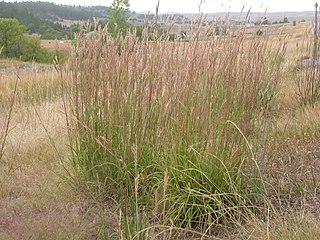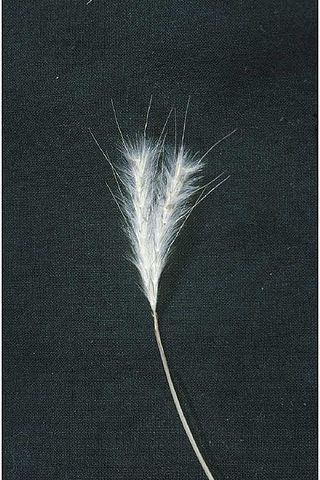
Andropogon gerardi, commonly known as big bluestem, is a species of tall grass native to much of the Great Plains and grassland regions of central and eastern North America. It is also known as tall bluestem, bluejoint, and turkeyfoot.

Andropogon is a widespread genus of plants in the grass family, native to much of Asia, Africa, and the Americas, as well as southern Europe and various oceanic islands.
Bluestem can refer to various grasses:
Andropogon benthamianus is a species of grass in the family Poaceae. It is found only in Ecuador, where it is known from only a single collection. It has been listed as critically endangered, and is feared extinct today.

Andropogon glomeratus is a species of grass known by the common names bushy bluestem and bushy beardgrass. This bunchgrass is native to the Americas, where it is widespread. It has also naturalized in other areas.
Tussock grassland is a form of open grassland that is dominated by tussock grasses. It is common in some temperate grasslands, savannas, and shrublands ecoregions of the Southern Hemisphere. Tussock grasslands are usually typified by low rainfall and poor soils in which few plants other than hardy tussock grasses can flourish. They are predominantly populated by tufted grasses of the genera Agrostis, Andropogon, Chionochloa, Deschampsia, Festuca, Koeleria, Pentameris and Poa. The grasslands are found in New Zealand, Australia, Argentina, temperate areas of southern and eastern Africa, and some subantarctic islands.

Cymbopogon schoenanthus, the camel grass, camel's hay, fever grass, geranium grass, or West Indian lemon grass, is a herbal plant of Southern Asia and Northern Africa, with fragrant foliage.

Andropogon virginicus is a species of grass known by several common names, including broomsedge bluestem, yellowsedge bluestem and whiskey grass. It is native to the southeastern United States and as far north as the Great Lakes. It is known as an introduced species in California and Hawaii, where it is weedy.
Nomen illegitimum is a technical term, used mainly in botany. It is usually abbreviated as nom. illeg. Although the International Code of Nomenclature for algae, fungi, and plants uses Latin terms for other kinds of name, the glossary defines the English phrase "illegitimate name" rather than the Latin equivalent. However, the Latin abbreviation is widely used by botanists and mycologists.

Apluda is a genus of plants in the grass family native to Asia and to various islands in the Indian and Pacific Oceans.
Sehima is a genus of mostly Asian and African plants in the grass family.

Andropogon hallii is a sod-forming perennial species in the grass family, Poaceae. It is a bunchgrass which grows in tufts and can reach 7 feet in height under favorable conditions.

Bothriochloa bladhii is a Neotropic grass in the family Poaceae, found primarily in tropical Africa, and tropical and temperate Asia, and Australia. The type specimen was collected from China by Finnish botanist Peter Johan Bladh. The name of Bladh is honored in the specific epithet.

Andropogon gayanus. commonly known as gamba grass, Rhodesian blue grass, tambuki grass, and other names, is a species of grass native to most of the tropical and subtropical savannas of Africa.

Andropogon ternarius is a species of grass known by the common names split bluestem, splitbeard bluestem, silver bluestem, and paintbrush bluestem. It is native to the southeastern, east-central, and south-central parts of the United States, where it occurs from New Jersey south to Florida and west to Kansas, Oklahoma, and Texas.
Andropogon capillipes is a species of grass known by the common name chalky bluestem. It is native to the southeastern United States as far west as Texas.
Diectomis is a genus of tropical plants in the grass family. The only known species is Diectomis fastigiata, widespread across tropical parts of Africa, Asia, and the Americas.
Claviceps pusilla, also known as bluestem ergot, is a parasitic fungus primarily of the grass tribe Angropogoneae, particularly those in the tribe referred to as "bluestem". C. pusilla occasionally manifests characteristic triangular conidia which appear to be unique among Claviceps species.
Andropogon distachyos is a species of perennial herb in the family Poaceae. They have a self-supporting growth form and simple, broad leaves. Individuals can grow to 62 cm.









